
Wine Culture and Information since 2002 - Volume 22
 Wine Culture and Information since 2002 - Volume 22 |
|
Sauvignon BlancAmong the most unmistakable grapes of the world, Sauvignon Blanc, with its charming aromas and its fresh taste, always adds a special touch to its wines |
|
A grape from which are produced interesting wines and useful for the study of organoleptic evaluation for beginners certainly is Sauvignon Blanc, even though, of course, it is not the only one. Wines produced with this grape are frequently used to the introductory study of wine sensorial analysis just because of its particular organoleptic qualities. Sauvignon Blanc is a grape every good taster should be able to recognize, a skill which certainly is not hard to learn thanks to unmistakable aromatic characteristics of this grape. Sauvignon Blanc is considered as an aromatic grape, however it can be easily recognized for its rather “unusual” aromas and that often directly remind of smells of herbaceous and vegetal origin. Anyway Sauvignon Blanc is more than that. It seems Sauvignon Blanc originated in the Bordeaux area, where it is widely used for the production of dry white wines and to add a providential crispness to the renowned wines of Sauternes and Barsac. The French region which is usually related to this grape is the Loire Valley, to the north, and in particular, with a cool climate. The popularity of Sauvignon Blanc has gone beyond the borders of what was considered for many years its favorite land - France - and spread in almost every wine producing country of the world. In fact many producers, in particular the ones from the so called “New World”, enchanted by the magic of Sancerre and Pouilly-Fumé wines, produced in the Loire Valley, have tried to imitate that style and often adding new elements, such as the use of cask, while giving origin to new styles of wines. Today Sauvignon Blanc is considered as an international grape and everywhere it is very appreciated thanks to its organoleptic qualities. As always, and just like for any other grape, not all the Sauvignon Blanc out there is worth of attention and in some cases the results are widely different from what it is considered as a “reference model” and on which it can be recognized the typicality of this grape.
The characteristic which mainly distinguishes Sauvignon Blanc are its aromas that remind herbs and vegetables, they often resemble nettle and green bell pepper, as well as more “unusual” aromas that no one would expect to find in a wine, such as the one of cat urine. Indeed the aromas of Sauvignon Blanc are also completed by charming hints of fruits, frequently resembling tropical fruits, such as litchi, pineapple and passion fruit, as well as pretty rich flowery aromas. As always, the nature and the quality of any grape's aromas are affected by many factors, including the type of soil in which the vine is being cultivated, climate, ripeness at the time of harvesting and, last but not the least, the way it is being vinified and, of course, the specific aromatic qualities of the grape itself. The choice of the type of aromas in wines made with Sauvignon Blanc is also connected to productive reasons and whereas once was favored the exaltation of herbaceous and vegetal aromas - a typical characteristic in Sancerre and Pouilly-Fumé wines - today it is common to favor the development of fruity aromas. Sauvignon Blanc is also unmistakable for its taste and thanks to its typical crispness - almost a personal mark which is added to its aromas, therefore its taste - wines produced with this grapes are always pleasing and “intriguing”. Even Sauvignon Blanc's crispness is considered a typical characteristic, a quality which tends to lose within few years of aging as well as its crispness and freshness of aromas: for this reason it is preferred to drink its wines in their youth. Saved few and rare exceptions, including few Pouilly-Fumé produced in the small town of Pouilly-Sur-Loire, wines produced with Sauvignon Blanc, fermented and aged in steel tanks, do not stand to aging times longer than two or three years. After this period the wine loses most of its typical qualities while getting a “round” character and a lesser aromatic freshness. Sauvignon Blanc is mainly fermented and aged in steel tanks, in order to keep its organoleptic qualities, however some producers vinify this grape in casks. Despite the fermentation and aging of Sauvignon Blanc in cask, more frequently in barrique, contributes to the loss of the grape's typicality while adding the one of wood, the obtained wine has the capacity to stand to longer aging times. A Sauvignon Blanc vinified in cask usually has the capacity to live about two years longer and it usually gives and develops its best after about two years from production. The bunch of Sauvignon Blanc is pretty small and despite the fact it is common in the majority of the wine producing countries of the world, in order to give its best it needs pretty particular cultural conditions. Sauvignon Blanc ripens pretty late, however it can be harvested early according to the style of wine to be produced. The time of harvesting represents a critical factor: in case it is being harvested too early, the grape has little acidity and little aromas, whereas when it is being harvested too late, it loses part of its typical acidity. Moreover it is rather sensible to the development of molds - in particular Botrytis Cinerea - therefore it requires a higher attention and care during the cultivation practices. The formation of Botrytis Cinerea is generally wished for the production of botrytized wines, such as Sauternes and Barsac, where Sauvignon Blanc is frequently used to add crispness to Sémillon. Sauvignon Blanc prefers cool climates - such as the one of Loire Valley - a condition that allows the development of the best and most refined aromas, too precious in order to be covered by the aromas of wood. It is not by chance that in areas with warm climates, such as California, this grape is often fermented and aged in cask. Even the composition of the soil plays a fundamental role for the development of Sauvignon Blanc. The best results seem to be obtained in siliceous soils - which exalt its aromas - a condition that can be found, for example, in the Loire Valley. No matter it was the Loire to mainly influence the style of wines produced with Sauvignon Blanc, fermented and aged in steel tanks, the area itself has recently underwent the style of other countries, in particular the one of California. In this state, where they tried in the beginning to imitate the Loire method, they began to make use of the barrique for this grape therefore creating, as a matter of fact, a new style which was in turn used by some French producers as well. Without considering any personal preference about wines produced in casks or in steel tanks, the style which best suits and is expected from Sauvignon Blanc is the one obtained with the vinification in inert containers, such as stainless steel, and that fully keep and exalt the aromatic and gustatory qualities of the grape. In fact they are its aromatic qualities, often enriched by vegetal and herbaceous hints, to make Sauvignon Blanc interesting and unmistakable. The same is also true for its typical fresh taste which would be attenuated and “smoothened” by the effects of the fermentation and aging in cask.
|
||||||||
|
Sauvignon Blanc, like we said, is preferably cultivated in cool areas and vinified in steel tanks, therefore its most typical color is greenish yellow. It is not however rare to find wines produced with this grapes having more intense colors and tending to straw yellow, a sign, in case of young wines, of the cultivation of grapes in warm areas or fermented and aged in cask. Wines produced with Sauvignon Blanc are usually consumed during their youth, certainly the best period, however when it is allowed to age for some years in the bottle, the evolution of colors follows the typical course of white wines. The color of aged Sauvignon Blanc tends to change the hue from greenish yellow to straw yellow and then golden yellow, anyway, as opposed to other white wines, the intensity of colors usually is not accentuated and deep.
|
|
Sauvignon Blanc is considered as an aromatic grape and its presence in wines is easily recognizable thanks to the richness and variety of aromas. The aromatic characteristics of Sauvignon are strongly influenced by three main factors - certainly applicable to any other grape - and that greatly affect its personality. The two main factors are the climate of the area in which the grape was cultivated and the ripeness at the time of harvesting. The third factor, representing for this grape an uncommon condition, is determined by the fermentation and the aging in cask. It should be remembered the most frequent and typical way of vinification for Sauvignon Blanc is done in steel tanks or inert containers. Despite the way Sauvignon Blanc was vinified and the area in which it was cultivated, this grape always has an elegant aroma which distinguishes every aromatic grape and that directly resembles the aroma of grape. In case Sauvignon Blanc was cultivated in cool areas, or harvested when it reached an optimal ripeness, the aromas distinguishing the wine directly resemble vegetal and herbaceous smells, in particular green bell pepper, bruised black currant leaf, mown grass and nettle, as well as the aroma which distinguishes more than any other else Sauvignon Blanc, that is the smell of cat urine which also resembles the aroma of box flowers. Besides these aromas there also are the ones of elder and citrus fruits. In case Sauvignon Blanc was cultivated in warm areas or harvested when it reached full ripeness, its typical vegetal and herbaceous aromas are very low - however recognizable, according to area of origin - whereas are exalted aromas of fruits, in particular peach and tropical fruits, as well as flowery aromas - such as elder, broom, acacia and hawthorn - and the characteristic aroma of grape. Whereas once was preferred to distinguish Sauvignon Blanc with herbaceous and vegetal aromas, today it is preferred to make it in a way that exalts the fresh and inviting aromas of flowers and fruits. The fermentation and aging in cask give the grape complex, rich and spicy aromas, including the aroma of vanilla and toasted wood which sometimes excessively cover the aromatic character of this grape.
|
||||
|
The main gustatory characteristic of Sauvignon Blanc certainly is its zesty acidity. These wines are usually produced with a medium-high alcoholic percentage, a factor which is also justified by the high acidity of the grape and therefore requires proper “corrections” in order to be balanced. No matter the balance of the wine is more or less correct, the acidity is the characteristic which allows Sauvignon Blanc to be recognized and this quality certainly is very appreciated and appropriate for this kind of wine and for the aromatic nature of its aromas. Sauvignon Blanc makes wines with pretty vast structures and bodies which are influenced by the climate in which the grape was cultivated, the type of soil and ripeness. Wines produced with this grape can have from pretty delicate structures to a good body, a characteristic which is frequently determined by the method of vinification and in particular by the use of cask. The gustatory agreeability - and certainly aromatic as well - of Sauvignon Blanc is mainly appreciable during its youth, when the aromas, and therefore taste, keep the freshness of fruits and flowers with a pleasing and appreciable crispness. With aging - in general terms Sauvignon Blanc is not well suited for aging times longer than three years - the wine loses its typical freshness and the taste becomes more round and less acid, probably less pleasing and typical. Sauvignon Blancs vinified in inert containers, such as stainless steel, are usually dry and aromatic, whereas the ones fermented or aged in cask, have a more round and complex character where acidity certainly is less appreciable. Sauvignon Blanc is also used for the production of many sweet wines, in particular botrytized wines, such as Sauternes and Barsac, in which the acid contribution, as well as aromatic, allows these wines to have a good balance while avoiding them to be too sweet and sickly.
|
|
Sauvignon Blanc is a grape which is usually appreciated by consumers, generally enchanted by its aromatic and gustatory characteristics. Because of its spreading, today Sauvignon Blanc is considered among the so called “international” grapes and it is virtually present in every wine producing country of the world. There can be distinguished two production styles and that mainly distinguish the area of origin as well: Sauvignon Blanc vinified in steel tanks and the ones vinified in cask and other wood containers. The main area where Sauvignon Blanc is vinified without using any cask, as well as being considered as the reference land for this grape, certainly is Loire Valley in France. Here wines are characterized by herbaceous and vegetal aromas, as well as “smoky” such as the renowned Pouilly-Fumé. Among other examples of Loire should certainly be mentioned Sancerre, Touraine and Menetou-Salon. In Bordeaux this grape is present in the dry wines of Entre-Deux-Mers and Bergerac where the influence of a warmer climate is pretty evident. Also in Italy Sauvignon Blanc is mainly vinified in steel tanks, in particular in Alto Adige and in the Collio area in Friuli Venezia Giulia. The country which was capable to get distinguished with Sauvignon Blanc wines certainly is New Zealand, in particular the area of Marlborough where wines have a good acidity and a character resembling the ones of Loire. Sauvignon Blanc is also present in South Africa, in particular in the Stellenbosch area, Hungary, Australia, no matter here the climate is rather warm for this grape, and in Chile, where it is often confused with the less aromatic Sauvignon Vert. The practice of vinifying Sauvignon Blanc in casks is typical in the areas having a warmer climate, of which California certainly is the most representative one and where it was created a particular style of Sauvignon Blanc fermented and aged in cask called Fumé Blanc. The “fashion” of vinifying Sauvignon Blanc in casks has also reached Loire Valley, where some Pouilly-Fumé producers decided to make use of wood containers instead of the traditional steel tanks. Also in Pessac-Léognan, in the Bordeaux area, some producers make use of this vinification technique, and other examples of Sauvignon Blancs vinified in cask are offered by Italy, New Zealand, South Africa and Chile.
|
Wines of the Month |
|
|
|
Score legend Prices are to be considered as indicative. Prices may vary according to the country or the shop where wines are bought |
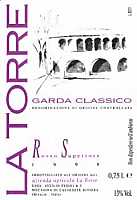
|
|
Garda Classico Rosso Superiore 2000 |
|
| La Torre - Pasini (Italy) | |
| Grapes: Marzemino, Groppello, Barbera, Sangiovese | |
| Price: € 7,16 | Score: |
| This wine shows a deep ruby red color and nuances of ruby red, little transparency. The nose reveals intense, clean and pleasing aromas which start with hints of black cherry and blueberry followed by aromas of blackberry, plum, violet, vanilla and hints of licorice. In the mouth has good correspondence to the nose, a slightly tannic attack and however balanced by alcohol, good body, intense flavors, good tannins. The finish is persistent with flavors of black cherry and plum. This wine ages for 7-8 months in barrique and for 6 months in bottle. | |
| Food Match: Roasted meat, Broiled meat and barbecue, Stewed meat, Hard cheese | |
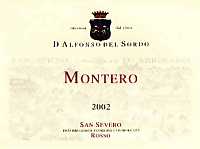
|
|
San Severo Rosso Montero 2002 |
|
| D'Alfonso del Sordo (Italy) | |
| Grapes: Montepulciano, Sangiovese | |
| Price: € 5,40 | Score: |
| The wine shows an intense ruby red color and nuances of ruby red, little transparency. The nose reveals intense, clean and pleasing aromas which start with hints of plum and black cherry followed by aromas of raspberry, cyclamen, blueberry, violet and pleasing hints of licorice. In the mouth has good correspondence to the nose, a slightly tannic attack and however balanced by alcohol, intense flavors, good body, good tannins. The finish is persistent with flavors of plum and black cherry. This wine ages for 4 months in barrique. | |
| Food Match: Sauteed meat with mushrooms, Broiled meat and barbecue, Roasted meat | |
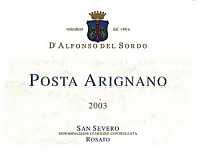
|
|
San Severo Rosato Posta Arignano 2003 |
|
| D'Alfonso del Sordo (Italy) | |
| Grapes: Montepulciano, Sangiovese | |
| Price: € 3,30 | Score: |
| The wine shows an intense cherry pink color and nuances of cherry pink, very transparent. The nose reveals clean and pleasing aromas which start with hints of cherry and raspberry followed by aromas of strawberry, cyclamen, pomegranate and peach. In the mouth has good correspondence to the nose, a slightly crisp attack and however balanced, good body, intense flavors, pleasing. The finish is persistent with flavors of cherry and peach. | |
| Food Match: Fish soups, Mushrooms soups, Pasta with mushrooms, Roasted fish | |
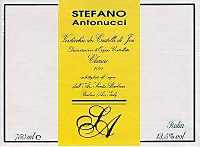
|
|
Verdicchio dei Castelli di Jesi Classico Stefano Antonucci 2001 |
|
| Santa Barbara (Italy) | |
| Grapes: Verdicchio | |
| Price: € 8,00 | Score: |
| This Verdicchio shows a pale golden yellow color and nuances of straw yellow, very transparent. The nose reveals good personality with intense, clean, pleasing and refined aromas which start with hints of peach and pear followed by good aromas of hawthorn, chamomile, broom, toasted wood, banana, apple and a pleasing hints of lavender. In the mouth has good correspondence to the nose, a crisp attack and however balanced by alcohol, good body, intense flavors, agreeable. The finish is persistent with flavors of apple and peach. A well made wine. This Verdicchio ages for 18 months in barrique. | |
| Food Match: Stuffed pasta with mushrooms, Roasted white meat, Roasted fish, Sauteed meat | |
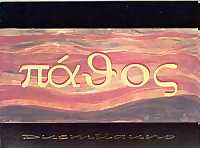
|
|
Pathos 2001 |
|
| Santa Barbara (Italy) | |
| Grapes: Merlot (33%), Cabernet Sauvignon (33%), Syrah (33%) | |
| Price: € 24,00 | Score: |
| This wine shows a deep ruby red color and nuances of ruby red, impenetrable to light. The nose reveals great personality with intense, clean, pleasing, refined and elegant aromas which start with intense hints of plum, black currant, black cherry and violet followed by good and intense aromas of blackberry, licorice, tobacco, cocoa, vanilla, toasted wood and good hints of black pepper and eucalyptus. In the mouth has very good correspondence to the nose, a tannic attack and however well balanced by alcohol, full body, intense flavors, agreeable. The finish is very persistent with long and good flavors of black cherry, plum and blackberry. A great wine, very elegant. | |
| Food Match: Game, Braised and stewed meat, Hard cheese | |
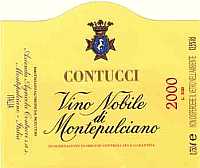
|
|
Vino Nobile di Montepulciano 2000 |
|
| Contucci (Italy) | |
| Grapes: Prugnolo Gentile (80%), Canaiolo Nero (15%), Mammolo (5%) | |
| Price: € 10,00 | Score: |
| The wine shows a brilliant ruby red color and nuances of ruby red, moderate transparency. The nose denotes intense, clean, pleasing and elegant aromas which start with hints of black cherry, plum and raspberry followed by aromas of blackberry, blueberry, licorice, carob, violet and vanilla. In the mouth has good correspondence to the nose, a slightly tannic attack and however balanced, good body, intense flavors, good tannins, agreeable. The finish is persistent with flavors of black cherry, blueberry and plum. A well made wine that ages for 18 months in cask and for 6-8 months in bottle. | |
| Food Match: Stewed meat with mushrooms, Roasted meat, Broiled meat and barbecue, Hard cheese | |
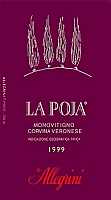
|
|
La Poja 1999 |
|
| Allegrini (Italy) | |
| Grapes: Corvina | |
| Price: € 49,00 | Score: |
| A great wine. It shows a deep ruby red color and nuances of garnet red, impenetrable to light. The nose reveals great personality with intense, clean, pleasing, refined and very elegant aromas that start with hints of plum, blackberry and black cherry followed by good and intense aromas of blueberry, violet, licorice, vanilla, cocoa, cinnamon and hints of menthol and thyme. In the mouth has very good to the nose, a slightly tannic attack and however well balanced by alcohol, full body, intense flavors, good tannins, very agreeable. The finish is very persistent with long flavors of plum, black cherry, blueberry and blackberry. A magnificent wine. La Poja is produced with overripe grapes and ages in cask for 20 months followed by 16 months in bottle. | |
| Food Match: Braised and stewed meat with mushrooms, Roasted meat, Game, Hard cheese | |
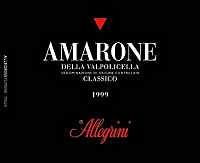
|
|
Amarone della Valpolicella Classico 1999 |
|
| Allegrini (Italy) | |
| Grapes: Corvina (75%), Rondinella (20%), Molinara (5%) | |
| Price: € 44,00 | Score: |
| This Amarone shows a deep ruby red color and nuances of garnet red, impenetrable to light. The nose reveals personality with intense, clean, pleasing, refined and elegant aromas which start with good hints of blackberry jam and black cherry jam followed by good and intense aromas of blueberry, plum, dried violet, tobacco, licorice, cinnamon, cocoa, vanilla and hints of cinchona and enamel. In the mouth has very good correspondence to the nose, a slightly tannic attack and however well balanced by alcohol, full body, intense flavors, good tannins, pleasing. The finish is very persistent with good and long flavors of blackberry, black cherry and plum. A very well made wine. This Amarone ages for 19 months in cask followed by 14 months of aging in bottle. | |
| Food Match: Roasted meat, Braised and stewed meat, Game, Hard cheese | |

|
|
Collio Pinot Grigio 2002 |
|
| Villa Russiz (Italy) | |
| Grapes: Pinot Gris | |
| Price: € 13,00 | Score: |
| This Pinot Gris shows a brilliant greenish yellow color and nuances of greenish yellow, very transparent. The nose reveals intense, clean, pleasing, refined and elegant aromas that start with hints of pear, apple and pineapple followed by aromas of hawthorn, banana, broom, litchi, hazelnut and grapefruit. In the mouth has good correspondence to the nose, a crisp attack and however balanced by alcohol, good body, intense flavors, agreeable. The finish is persistent with flavors of pineapple, pear and litchi. A well made wine. This Pinot Gris ages in steel tanks for at least 8 months. | |
| Food Match: Eggs, Fried fish, Fish Appetizers, Pasta and risotto with crustaceans | |

|
|
Collio Sauvignon De La Tour 2002 |
|
| Villa Russiz (Italy) | |
| Grapes: Sauvignon Blanc | |
| Price: € 25,00 | Score: |
| This wine shows an intense greenish yellow color and nuances of greenish yellow, very transparent. The nose reveals good personality with intense, clean, pleasing, refined and elegant aromas that start with good hints of peach, elder and pineapple followed by good aromas of acacia, litchi, apple, broom, grapefruit and hints of sage. In the mouth has very good correspondence to the nose, a crisp attack and however well balanced by alcohol, good body, intense flavors, very agreeable. The finish is very persistent with long flavors of peach, pineapple and pear. A well made wine. This Sauvignon Blanc ages for 10 months in steel tanks. | |
| Food Match: Crustaceans, Pasta with fish and crustaceans, Stewed fish, Broiled fish | |
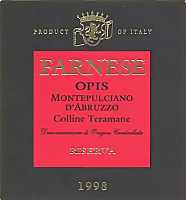
|
|
Montepulciano d'Abruzzo Colline Teramane Opis Riserva 1998 |
|
| Farnese (Italy) | |
| Grapes: Montepulciano | |
| Price: € 22,00 | Score: |
| The wine shows an intense ruby red color and nuances of garnet red, little transparency. The nose reveals intense, clean, pleasing, elegant and refined aromas which start with hints of black cherry and plum followed by good aromas of blueberry, tobacco, dried violet, licorice, carob, vanilla and hints of toasted wood, menthol and cinchona. In the mouth has good correspondence to the nose, a slightly tannic attack and however balanced by alcohol, full body, intense flavors, good tannins, agreeable. The finish is persistent with flavors of plum, black cherry and blueberry. A well made wine. This Montepulciano d'Abruzzo ages in barrique for 18 months and for 6 months in bottle. | |
| Food Match: Braised and stewed meat, Roasted meat, Hard cheese | |
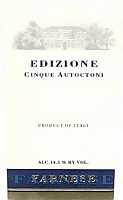
|
|
Edizione Cinque Autoctoni 2001 |
|
| Farnese (Italy) | |
| Grapes: Montepulciano (40%), Sangiovese (20%), Primitivo (25%), Negroamaro (10%), Malvasia Rossa (5%) | |
| Price: € 25,00 | Score: |
| This wine shows an intense ruby red color and nuances of ruby red, little transparency. The nose reveals good personality with intense, clean, pleasing, refined and elegant aromas which start with hints of black cherry jam and plum jam followed by aromas of blackberry, cinchona, blueberry, toasted wood, tobacco, licorice, violet, vanilla and hints of nutmeg and menthol. In the mouth has very good correspondence to the nose, a slightly tannic attack and however well balanced by alcohol, full body, intense flavors, good tannins, agreeable. The finish is persistent with good flavors of plum, black cherry and blackberry. A well made wine. Edizione Cinque Autoctoni ages in barrique for 12 months and for 6 months in bottle. | |
| Food Match: Game, Braised and stewed meat, Roasted meat, Hard cheese | |
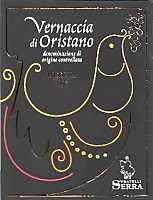
|
|
Vernaccia di Oristano Riserva 1992 |
|
| Fratelli Serra (Italy) | |
| Grapes: Vernaccia di Oristano | |
| Price: € 9,00 | Score: |
| The wine shows an intense amber yellow color and nuances of amber yellow, very transparent. The nose reveals intense, clean, pleasing and refined aromas which start with good hints of almond and fig jam followed by good aromas of caramel, leather, date, honey, orange marmalade and walnut. In the mouth has good correspondence to the nose, a slightly crisp and pleasing round attack, however balanced, full body, intense flavors, agreeable. The finish is persistent with flavors of caramel, fig jam, date and almond. This Vernaccia di Oristano ages in chestnut casks. | |
| Food Match: Almond desserts, Roasted meat, Braised meat | |
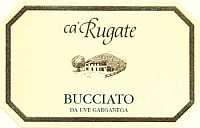
|
|
Bucciato 2002 |
|
| Ca' Rugate (Italy) | |
| Grapes: Garganega | |
| Price: € 13,50 | Score: |
| The wine shows a brilliant golden yellow color and nuances of golden yellow, very transparent. The nose reveals good personality with intense, clean, pleasing, refined and elegant aromas that start with hints of medlar, honey and hawthorn followed by good aromas of quince, pear, ripe peach, almond and a hint of vanilla. In the mouth has good correspondence to the nose, a crisp and pleasing round attack however well balanced by alcohol, good body, intense flavors, agreeable. The finish is persistent with flavors of ripe peach and quince. A well made wine. Bucciato is made from late harvest grapes and part of this wine ferments in cask. | |
| Food Match: Pasta with mushrooms, Mushrooms soups, Stewed fish, Roasted fish | |
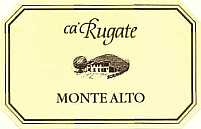
|
|
Soave Classico Monte Alto 2002 |
|
| Ca' Rugate (Italy) | |
| Grapes: Garganega | |
| Price: € 12,50 | Score: |
| This wine shows an intense straw yellow color and nuances of straw yellow, very transparent. The nose reveals good personality with intense, clean, pleasing, refined and elegant aromas which start with good hints of apple, pear and broom followed by good aromas of almond flowers, hawthorn, litchi, honey, ripe peach, plum and hints of vanilla. In the mouth has good correspondence to the nose, a crisp attack and however well balanced by alcohol, good body, intense flavors, pleasing roundness. The finish is persistent with good flavors of peach and pear. A well made wine. Monte Alto is produced with overripe grapes and ages in barrique for 6-8 months. | |
| Food Match: Pasta with mushrooms, Mushrooms soups, Sauteed white meat, Roasted and stewed fish | |
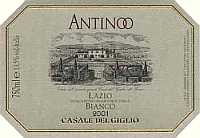
|
|
Antinoo 2001 |
|
| Casale del Giglio (Italy) | |
| Grapes: Chardonnay (66%), Viognier (34%) | |
| Price: € 10,00 | Score: |
| This wine shows a pale straw yellow color and nuances of straw yellow, very transparent. The nose reveals intense, clean, pleasing and elegant aromas which start with hints of peach, pear and toasted wood followed by good aromas of apple, pineapple, hawthorn, litchi, grapefruit and vanilla. In the mouth has good correspondence to the nose, a crisp attack and however balanced by alcohol, good body, intense flavors, pleasing. The finish is persistent with flavors of peach, pear and apple. Antinoo ages in barrique for 6-8 months. | |
| Food Match: Pasta with mushrooms, Sauteed meat with mushrooms, Fried and broiled fish | |
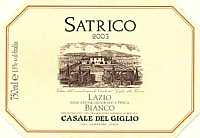
|
|
Satrico 2003 |
|
| Casale del Giglio (Italy) | |
| Grapes: Chardonnay, Sauvignon Blanc, Trebbiano Giallo | |
| Price: € 5,00 | Score: |
| This wine shows a brilliant greenish yellow color and nuances of greenish yellow, very transparent. The nose reveals intense, clean, pleasing, refined and elegant aromas that start with hints of peach, litchi and pineapple followed by good aromas of acacia, broom, pear, apple and hints of elder. In the mouth has good correspondence to the nose, a crisp attack and however well balanced by alcohol, good body, intense flavors, agreeable. The finish is persistent with flavors of peach, pear and pineapple. A well made wine. | |
| Food Match: Fish appetizers, Fried fish, Pasta and risotto with fish and crustaceans, Sauteed fish | |
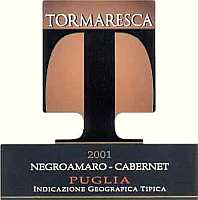
|
|
Tormaresca Rosso 2001 |
|
| Tormaresca (Italy) | |
| Grapes: Negroamaro (70%), Cabernet Sauvignon (30%) | |
| Price: € 7,00 | Score: |
| The wine shows a brilliant ruby red color and nuances of garnet red, little transparency. The nose reveals intense, clean, pleasing and elegant aromas which start with hints of raspberry and blueberry followed by aromas of strawberry, black cherry, cyclamen, plum and violet. In the mouth has good correspondence to the nose, a slightly tannic attack and however balanced, good body, intense flavors, good tannins. The finish is persistent with flavors of plum, black cherry and blueberry. This wine ages in steel tanks. | |
| Food Match: Roasted meat, Broiled meat and barbecue, Hard cheese | |
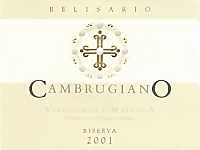
|
|
Verdicchio di Matelica Riserva Cambrugiano 2001 |
|
| Belisario (Italy) | |
| Grapes: Verdicchio di Matelica | |
| Price: € 8,80 | Score: |
| This wine shows a brilliant golden yellow color and nuances of golden yellow, very transparent. The nose reveals good personality with intense, clean, pleasing and elegant aromas that start with hints of pear, apple and toasted wood followed by good aromas of hawthorn, broom, pineapple, lemon, grapefruit, plum and vanilla. In the mouth has good correspondence to the nose, a crisp attack and however well balanced by alcohol, good body, intense flavors, agreeable. The finish is persistent with good flavors of plum, pear and pineapple. A well made wine. A small part of Cambrugiano ages in barrique for 12 months. | |
| Food Match: Roasted fish, Mushrooms soups, Roasted white meat, Stuffed pasta | |
|
|
|
Verdicchio di Matelica Passito Carpe Diem 2001 |
|
| Belisario (Italy) | |
| Grapes: Verdicchio di Matelica | |
| Price: € 8,50 - 500ml | Score: |
| This wine shows a brilliant amber yellow color and nuances of golden yellow, very transparent. The nose reveals good personality with intense, clean, pleasing, refined and elegant aromas which start with hints of dried apricot and peach jam followed by good aromas of candied fruit, caramel, ripe banana, dried fig, almond, honey, citrus fruit peel, vanilla and hints of enamel. In the mouth has very good correspondence to the nose, a sweet and slightly crisp attack however well balanced by alcohol, good body, intense flavors, pleasing sweetness. The finish is persistent with good flavors of apricot, peach and honey. A well made wine. Carpe Diem is produced is dried grapes and ages for 10 months in steel tanks and for 2 months in barrique. | |
| Food Match: Confectionery, Almond cakes, Hard and piquant cheese | |
|
||||||||
|
DiWineTaste Polls
|
| |||||||
Privacy Policy | |||||||


| Copyright © 2002-2024 Antonello Biancalana, DiWineTaste - All rights reserved |
| All rights reserved under international copyright conventions. No part of this publication and of this WEB site may be
reproduced or utilized in any form or by any means, electronic or mechanical, without permission in writing from DiWineTaste. |